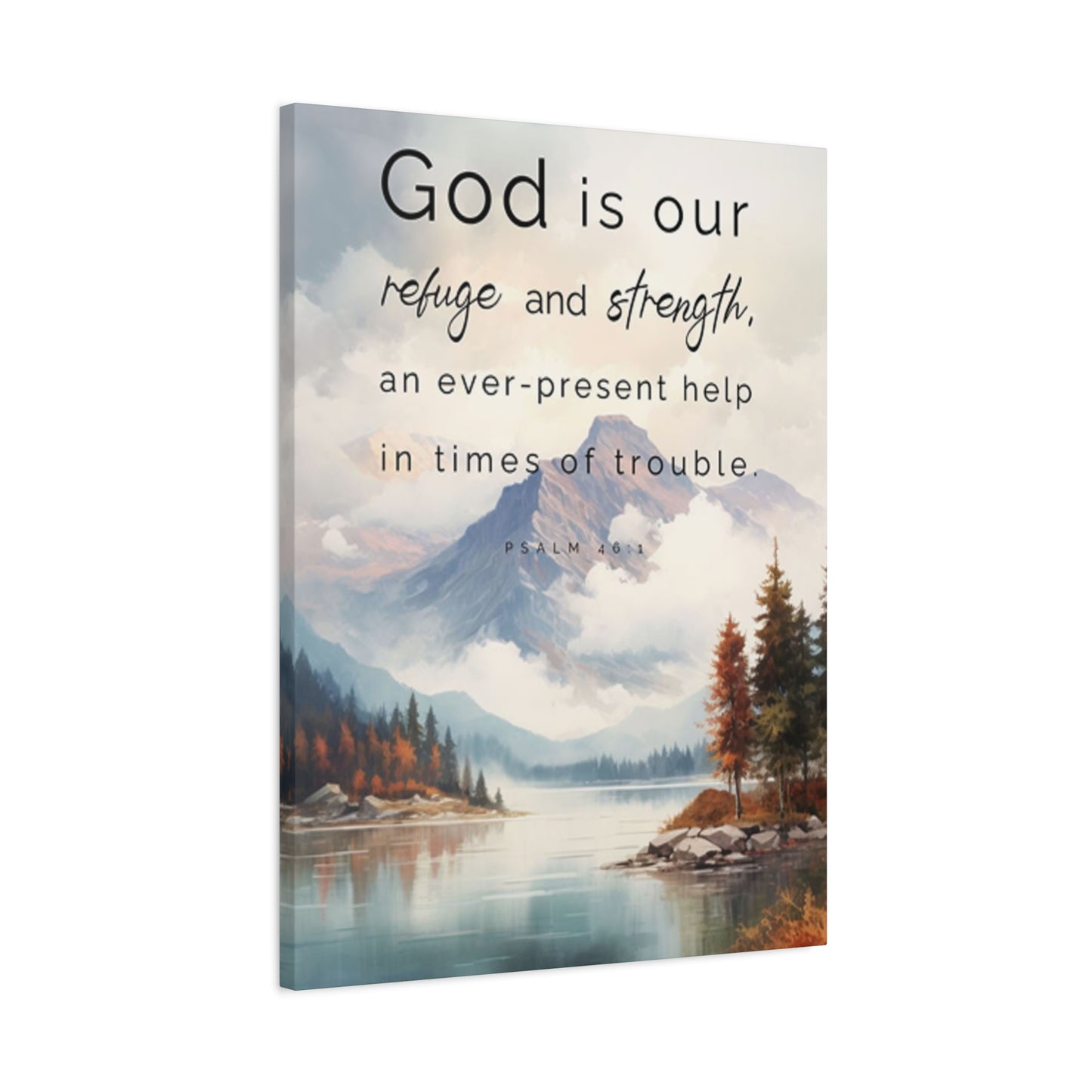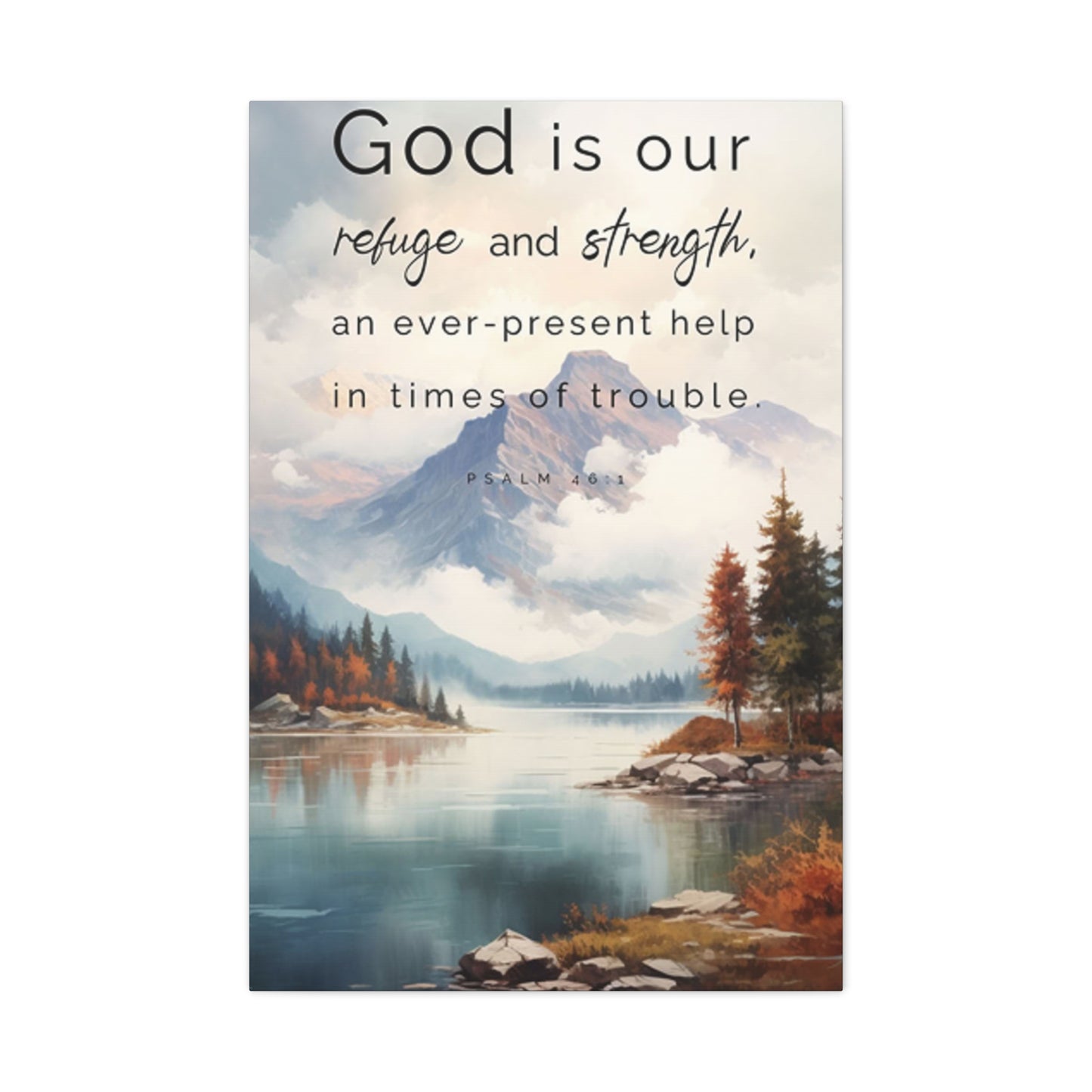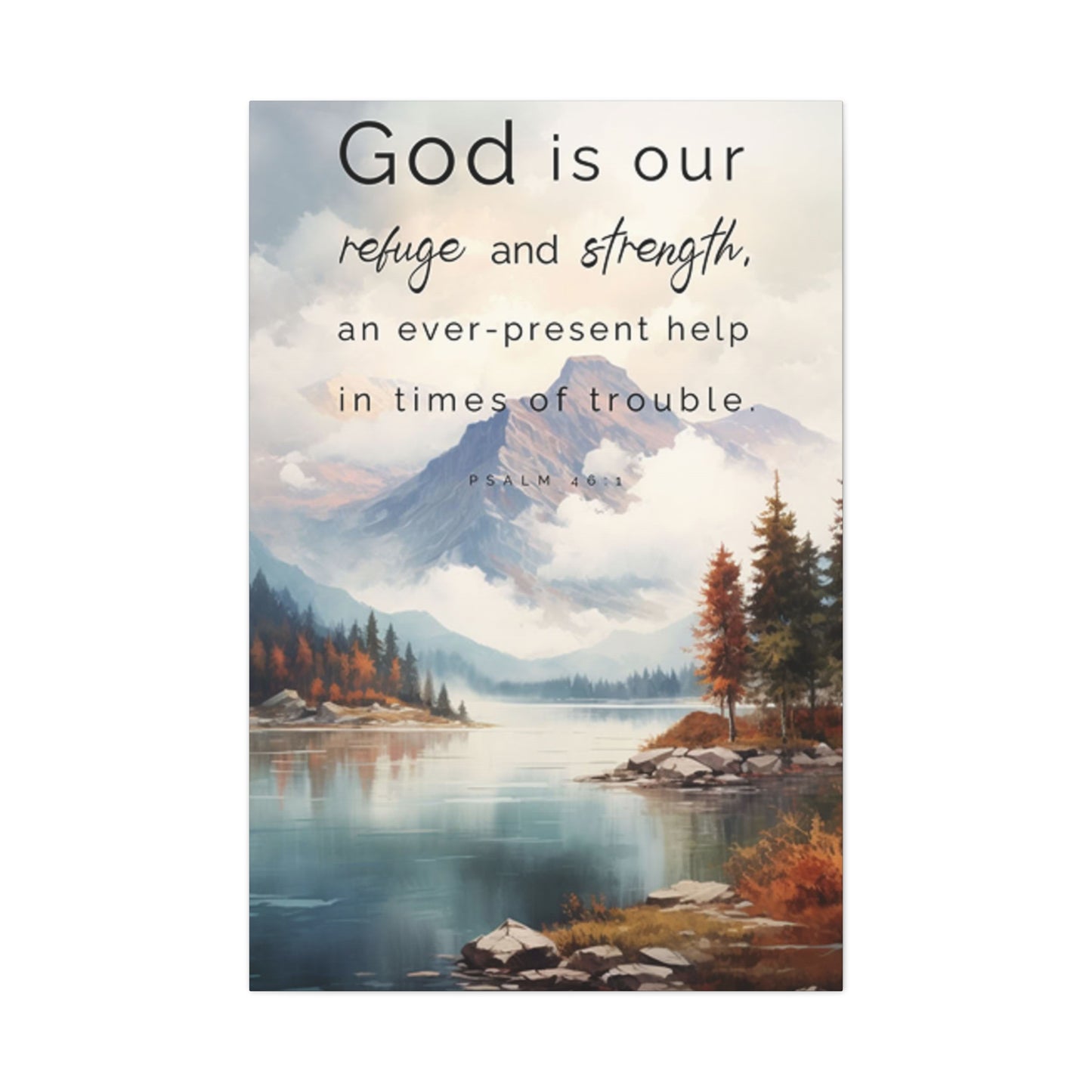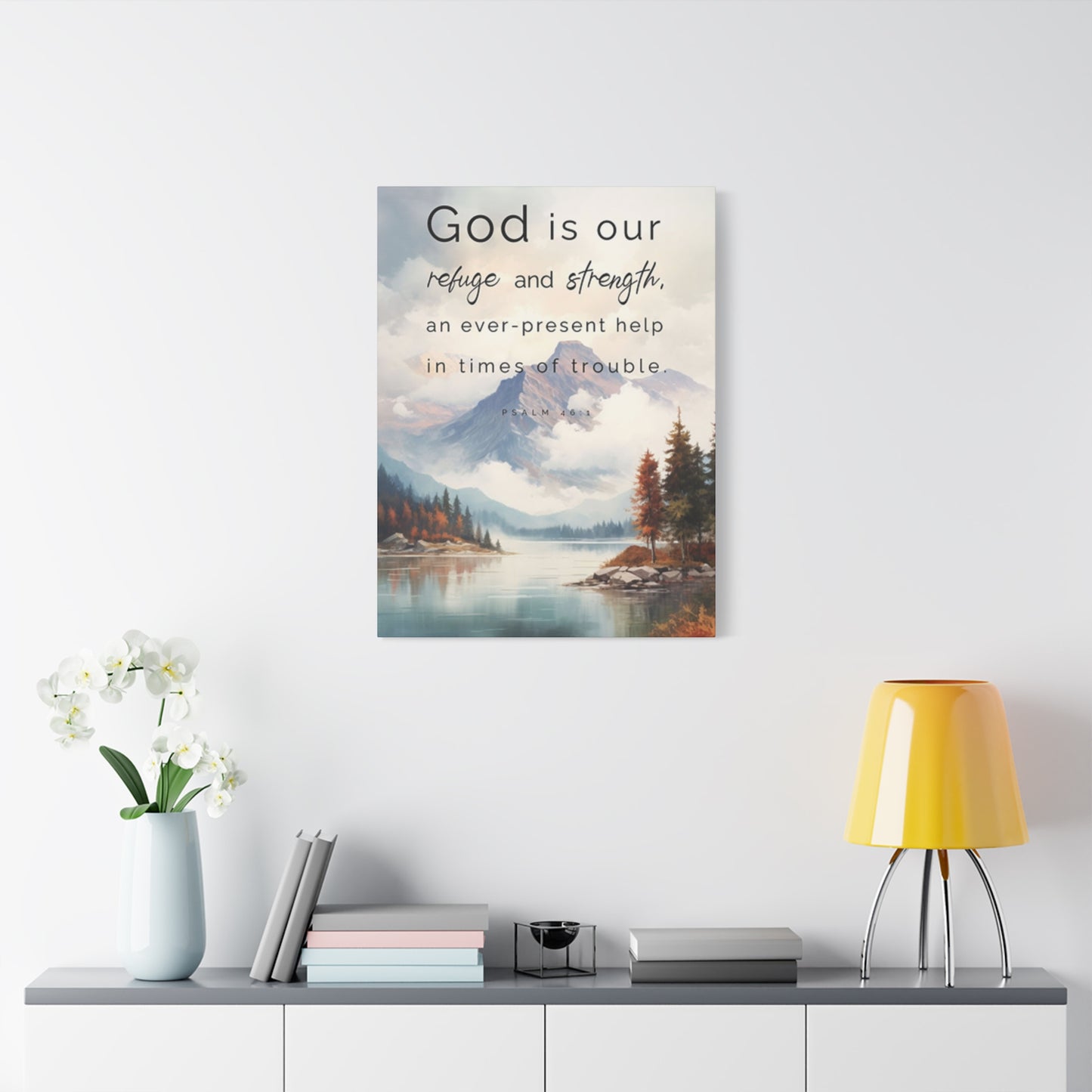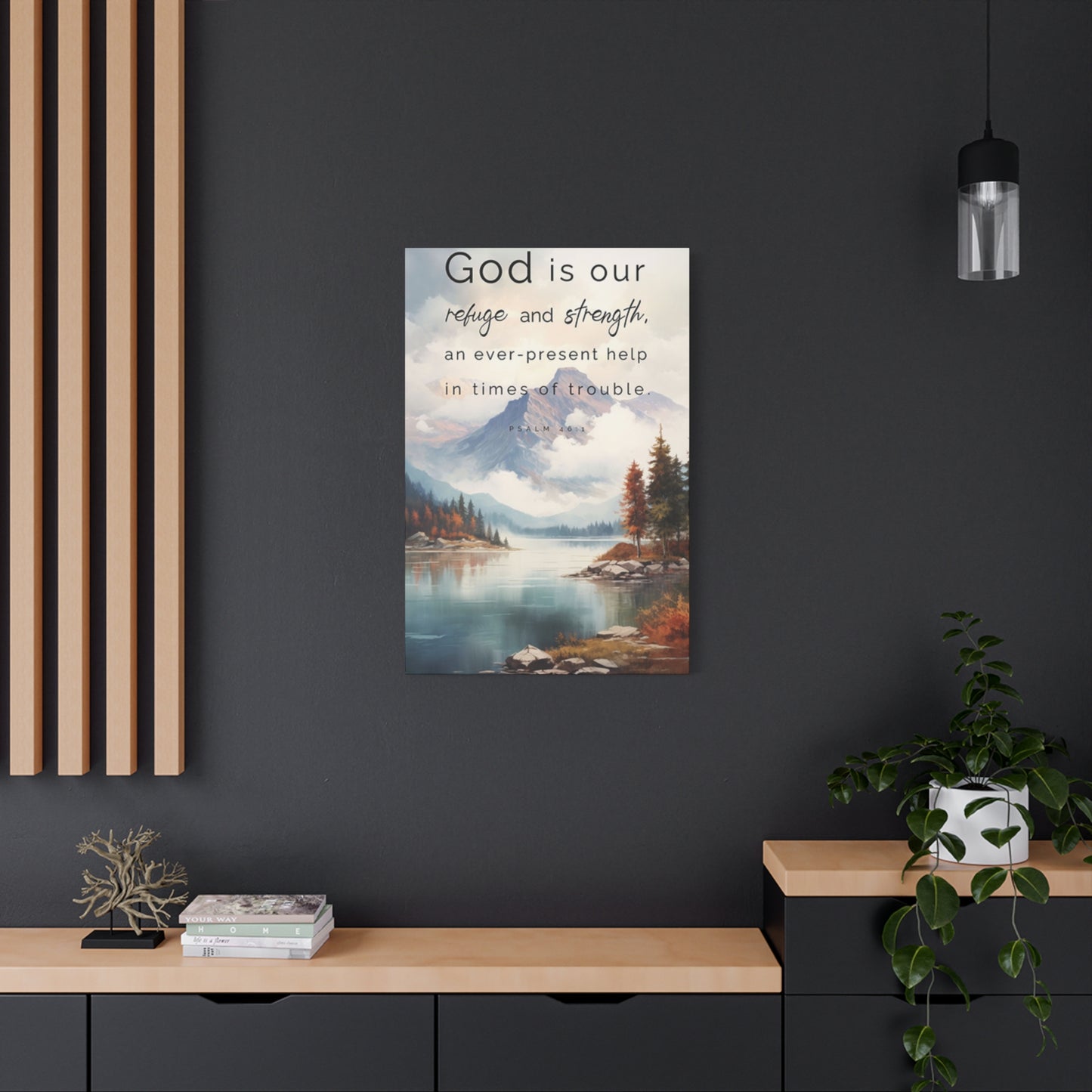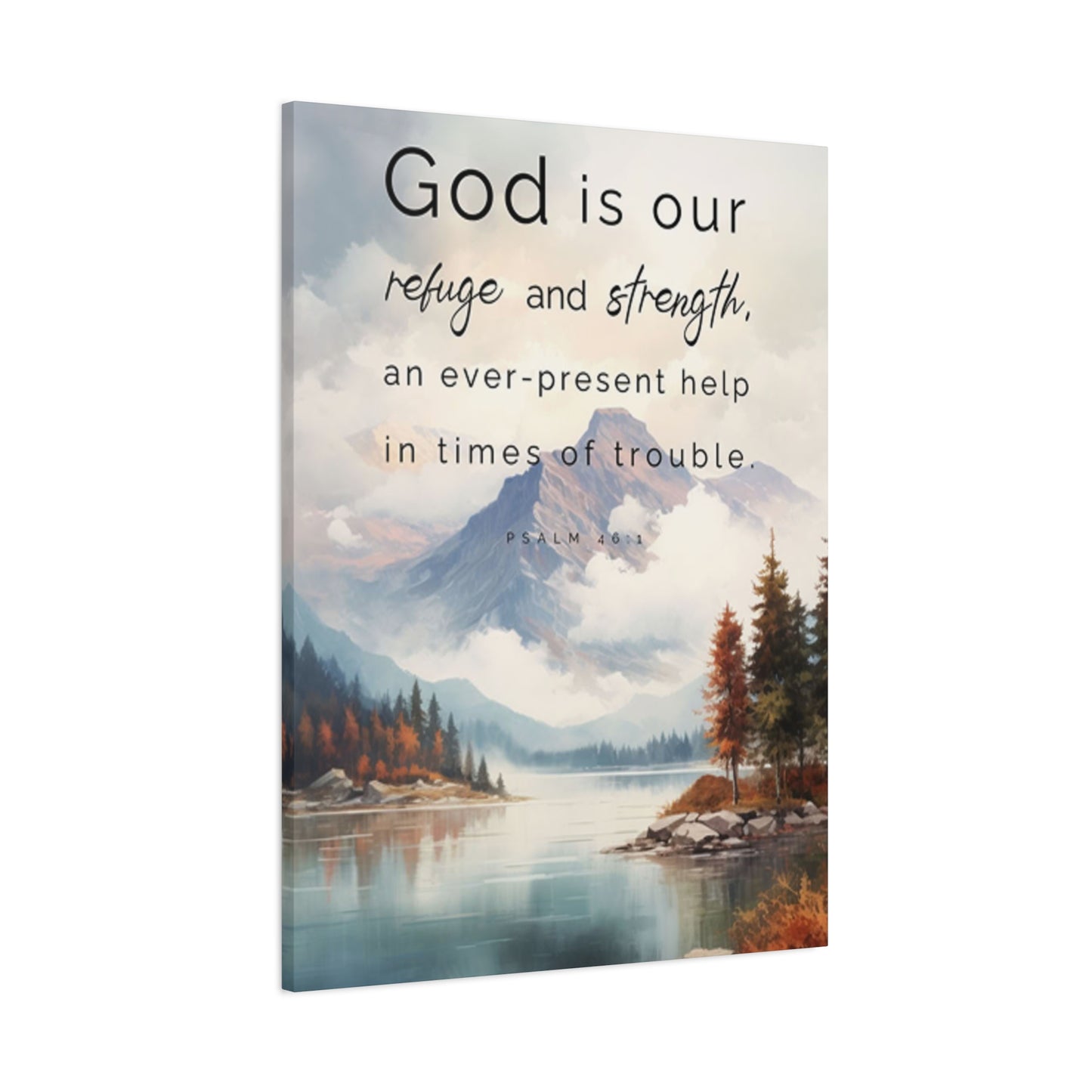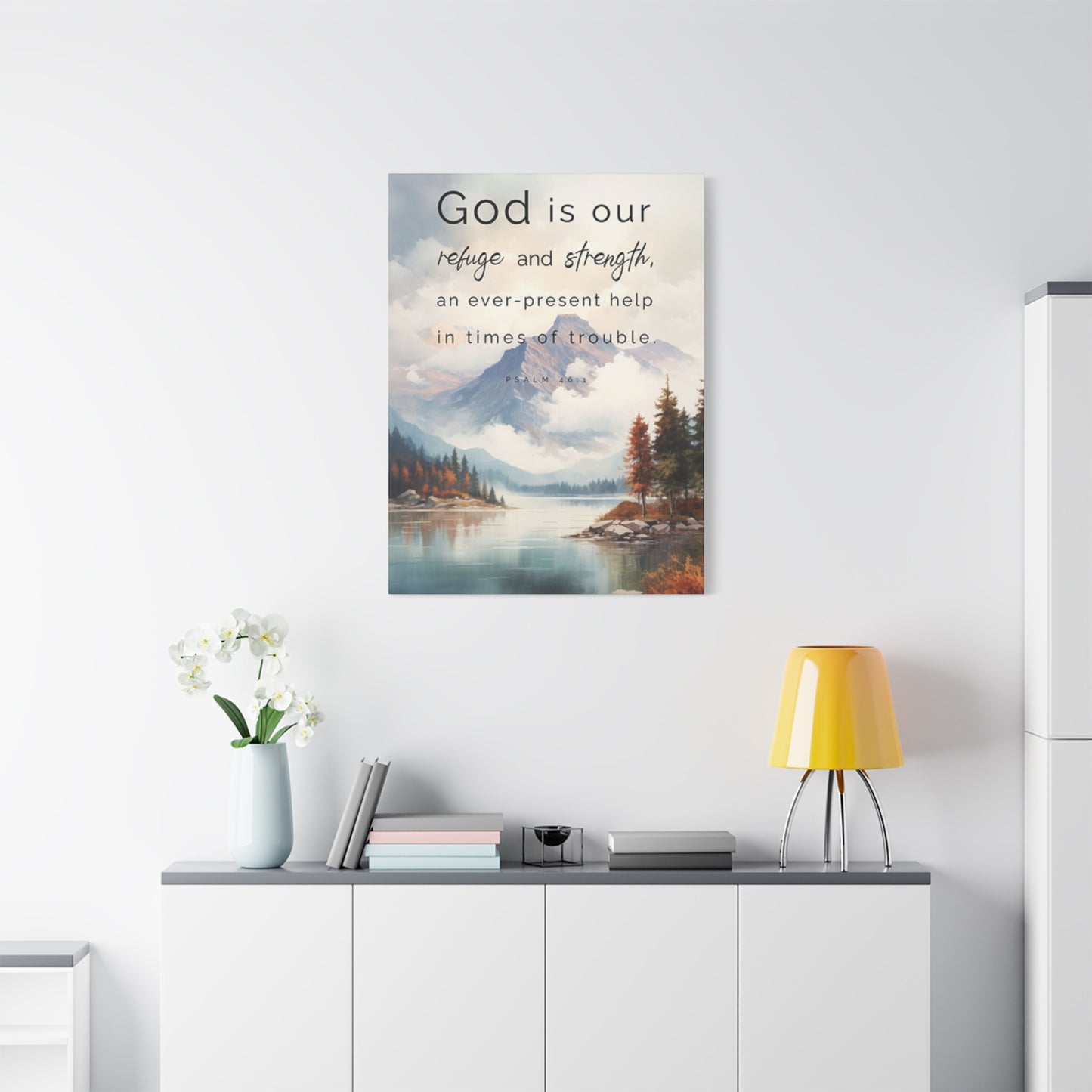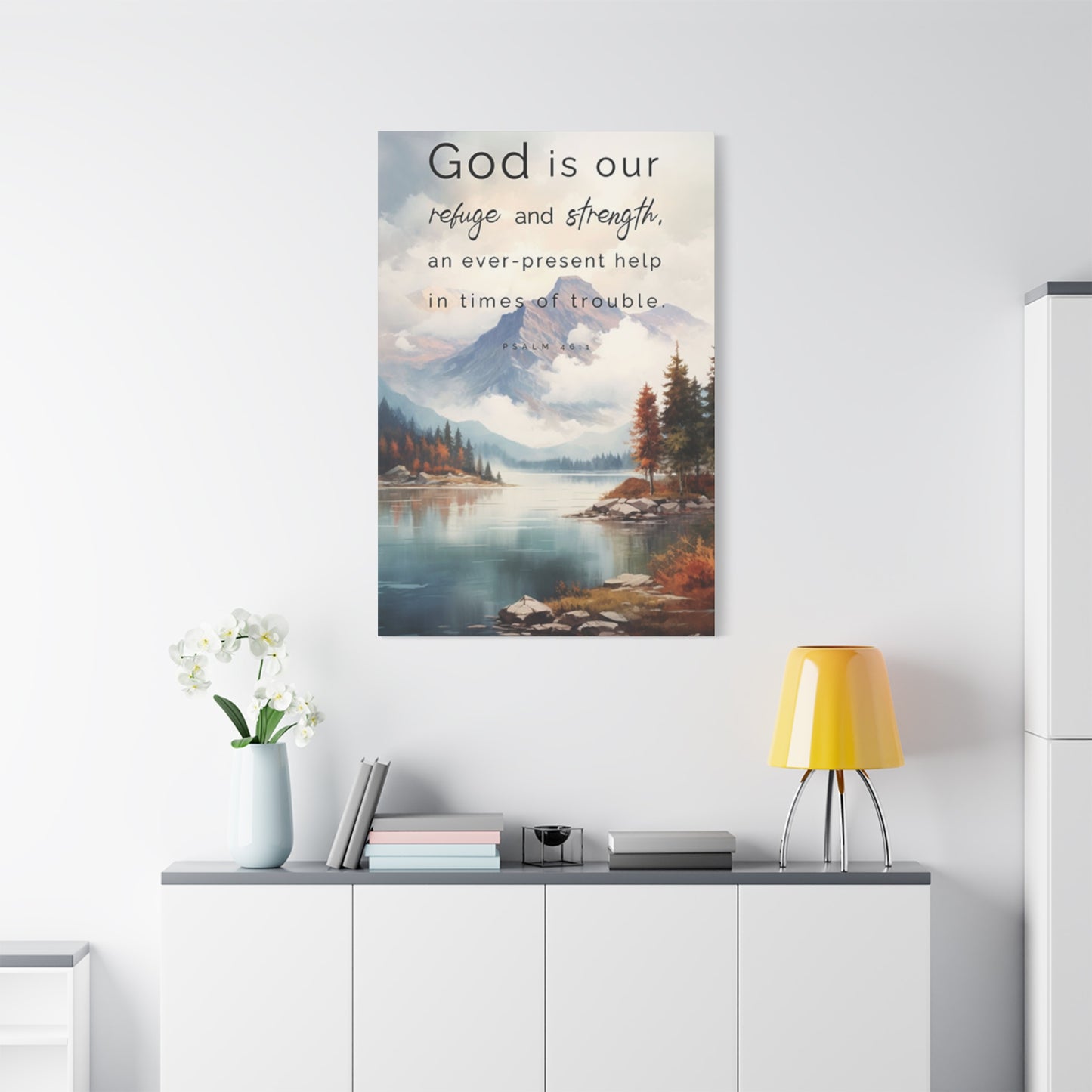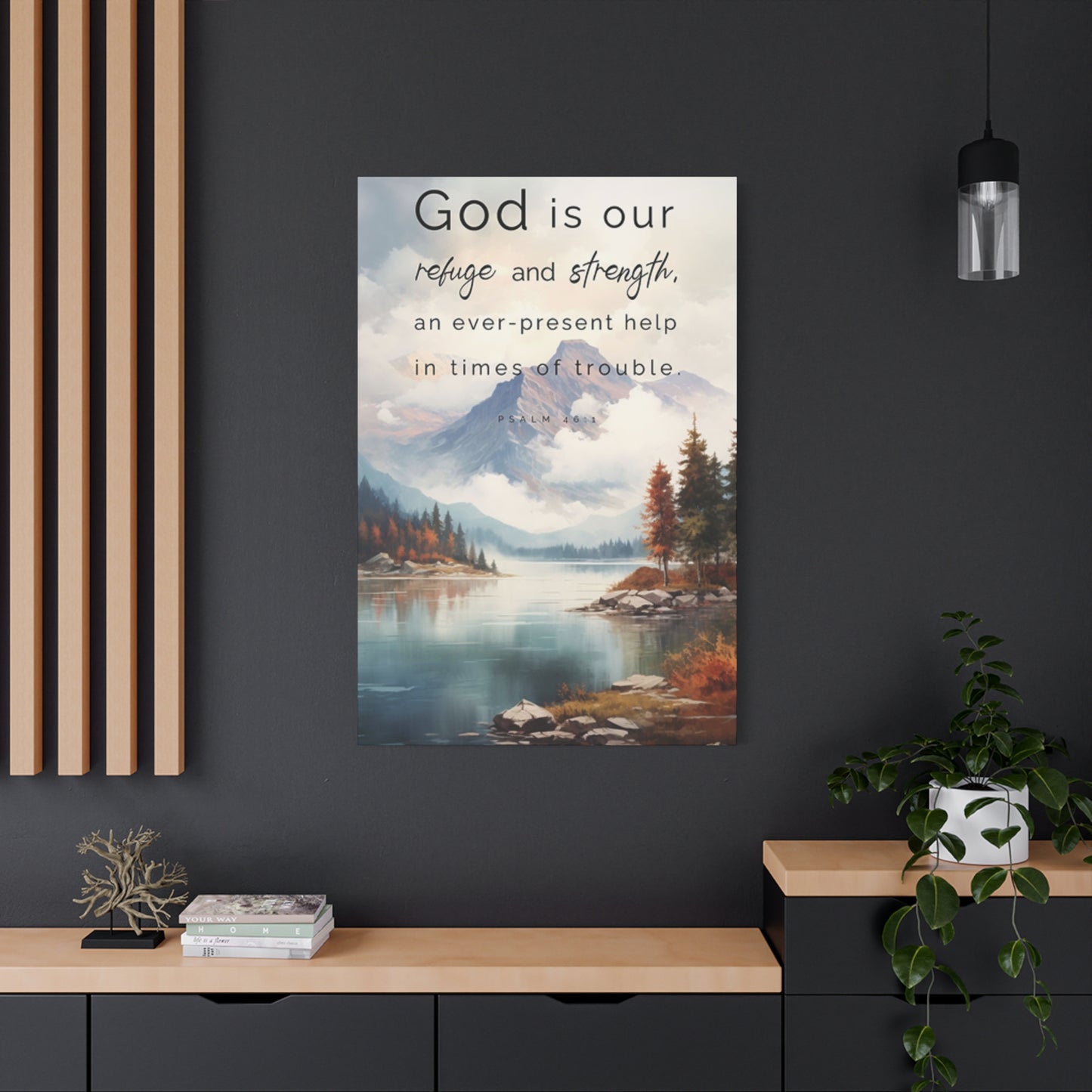God Is Our Refuge And Strength Poster Wall Art & Canvas Prints
God Is Our Refuge And Strength Poster Wall Art & Canvas Prints
Couldn't load pickup availability
Discover Divine Protection Through God Is Our Refuge And Strength Poster Wall Art: A Comprehensive Exploration of Faith-Based Home Decor
The concept of seeking solace and fortitude through spiritual beliefs has been a cornerstone of human existence since time immemorial. When individuals encounter turbulent circumstances, overwhelming challenges, or moments of profound uncertainty, they often turn to divine sources for comfort and empowerment. The sacred scripture from Psalms 46:1 declares a timeless truth that resonates deeply with believers across generations: "God is our refuge and strength, a very present help in trouble." This powerful declaration has transcended centuries, offering unwavering reassurance to countless souls navigating the complexities of earthly existence. Today, this profound message finds beautiful expression through carefully crafted decorative pieces that transform living spaces into sanctuaries of peace and spiritual connection.
The God Is Our Refuge And Strength Poster Wall Art represents more than mere decoration; it embodies a tangible reminder of divine protection and supernatural power available to those who place their trust in the Almighty. These carefully designed visual representations serve as constant companions throughout daily routines, speaking silent words of encouragement during moments when verbal affirmations seem insufficient. Unlike transient digital messages or fleeting verbal reassurances, these permanent fixtures in personal spaces provide steadfast reminders of eternal truths that remain unchanging regardless of external circumstances.
Exploring the Profound Spiritual Significance Behind Refuge and Fortitude Declarations
The declaration that the Creator serves as both sanctuary and might carries multilayered meanings that have captivated theologians, scholars, and ordinary believers throughout millennia. This dual characterization addresses two fundamental human needs: the necessity for protection from external threats and the requirement for internal strength to persevere through adversity. The term "refuge" evokes imagery of a fortified sanctuary where vulnerable individuals find shelter from storms, both literal and metaphorical. Throughout ancient civilizations, cities maintained protected areas where residents could flee during invasions or natural disasters, and this physical reality provides powerful context for understanding spiritual protection.
The concept of divine strength speaks to an entirely different dimension of human experience. While refuge addresses external circumstances, strength focuses on internal capacities and resources. Human beings possess finite reserves of physical, emotional, and mental energy. When these reserves deplete, individuals require supernatural replenishment from sources beyond their natural capabilities. The sacred texts repeatedly emphasize that divine power manifests most profoundly when human weakness becomes most apparent. This paradoxical principle challenges conventional wisdom that equates strength with self-sufficiency and independence.
The phrase "very present help in trouble" introduces a temporal dimension often overlooked in casual readings. The emphasis on presence suggests immediacy and accessibility rather than distant or theoretical assistance. Throughout scripture, numerous accounts demonstrate divine intervention arriving precisely when circumstances appear most hopeless. This consistent pattern establishes confidence that supernatural assistance remains perpetually available rather than restricted to specific times or circumstances. The God Is Our Refuge And Strength Poster Wall Art serves as a visual anchor for this theological reality, transforming abstract concepts into tangible daily reminders.
When believers surround themselves with visual representations of these truths, they create environments conducive to maintaining spiritual awareness throughout mundane activities. The human mind responds powerfully to visual stimuli, often processing images more rapidly and retaining them more effectively than verbal information alone. Neuroscientific research demonstrates that repeated exposure to meaningful imagery strengthens neural pathways associated with corresponding beliefs and behaviors. Therefore, strategically positioning faith-affirming artwork throughout living spaces potentially reinforces spiritual convictions at subconscious levels, influencing thoughts and attitudes even during periods when conscious spiritual practice may lapse.
Examining Various Artistic Interpretations and Design Variations Available
The market for faith-based decorative items has expanded dramatically in recent decades, reflecting both increased demand and improved production capabilities. Contemporary consumers encounter remarkable diversity in artistic styles, aesthetic approaches, and design philosophies when selecting pieces like the God Is Our Refuge And Strength Poster Wall Art. This variety enables individuals to select items that align with both their spiritual convictions and their personal aesthetic preferences, eliminating the false dichotomy between religious devotion and artistic sensibility.
Traditional approaches to religious artwork often incorporated classical elements reminiscent of Renaissance paintings or medieval illuminated manuscripts. These designs typically feature ornate calligraphy, elaborate borders, and rich color palettes dominated by deep blues, burgundies, and golds. Such pieces appeal to individuals who appreciate historical continuity and find comfort in visual connections to centuries of faithful witness. The gravitas conveyed through these classical designs communicates permanence and timelessness, suggesting that the truths depicted transcend temporary cultural trends.
Contemporary interpretations embrace minimalist aesthetics, favoring clean lines, simplified compositions, and restrained color schemes. These modern designs often utilize sans-serif typography, geometric shapes, and intentional negative space to create visual impact through subtlety rather than ornamentation. Younger believers frequently gravitate toward these streamlined presentations, finding that minimalist approaches align with current design sensibilities while maintaining theological substance. The God Is Our Refuge And Strength Poster Wall Art in contemporary formats demonstrates that ancient truths can speak compellingly to modern audiences without compromising essential messages.
Rustic and farmhouse styles have gained tremendous popularity in recent years, bringing weathered textures, distressed finishes, and natural materials into spiritual decor. These designs often incorporate wood grain backgrounds, vintage typography, and earth-tone color palettes that evoke feelings of warmth, authenticity, and groundedness. The rustic aesthetic particularly appeals to individuals seeking to create homes that feel welcoming, unpretentious, and connected to simpler ways of life. When combined with powerful scriptural declarations, these design elements suggest that profound spiritual truths need not present themselves through intimidating formality but can instead feel accessible and personally relevant.
Watercolor and artistic interpretations introduce creative expression and individual artistry into faith-based decor. These designs might feature hand-painted elements, abstract brushstrokes, or artistic flourishes that transform typography into visual art. Such pieces appeal to individuals who value creativity, artistic expression, and the unique rather than mass-produced uniformity. The God Is Our Refuge And Strength Poster Wall Art rendered in watercolor styles communicates that faith itself can be vibrant, dynamic, and personally expressive rather than rigidly formulaic.
Photographic backgrounds have emerged as another popular design approach, combining scriptural text with nature imagery such as mountains, oceans, forests, or sunsets. These compositions leverage the emotional impact of natural beauty to reinforce spiritual messages. The majesty of mountain ranges echoes divine strength, while the constancy of ocean waves suggests unchanging faithfulness. By pairing text with imagery, these designs engage multiple cognitive pathways simultaneously, potentially deepening emotional and spiritual impact compared to text-only presentations.
Understanding the Psychological Impact of Surrounding Yourself With Affirming Messages
The relationship between environmental influences and mental states has been extensively documented across multiple disciplines. Psychologists recognize that physical surroundings significantly affect mood, cognition, and behavior through mechanisms both conscious and subconscious. The practice of intentionally curating living spaces to support desired mental and emotional states represents a practical application of these principles. When individuals strategically position items like the God Is Our Refuge And Strength Poster Wall Art throughout their homes, they create what researchers term "priming environments" that subtly influence thoughts and feelings throughout daily activities.
Priming refers to the phenomenon whereby exposure to certain stimuli affects responses to subsequent stimuli without conscious awareness. For example, individuals who view words associated with aging subsequently walk more slowly, while those exposed to achievement-related words perform better on challenging tasks. These effects occur without deliberate thought, operating through subconscious associations activated by environmental cues. Applied to faith-based decor, this principle suggests that regular exposure to scriptural affirmations potentially activates corresponding mental frameworks, making thoughts of divine protection and strength more accessible during moments of need.
The concept of environmental press describes how physical spaces can either support or hinder desired behaviors and mental states. Environments characterized by chaos, disorganization, or negative imagery create psychological press toward stress, distraction, and negativity. Conversely, spaces designed with intention, order, and uplifting content foster psychological states conducive to peace, focus, and positivity. Religious decor functions as one element within broader environmental design, contributing to overall atmospheric qualities that either facilitate or impede spiritual awareness and practice.
Repetition plays a crucial role in cognitive processes related to belief formation and maintenance. Information encountered repeatedly becomes more familiar, and familiarity breeds both comfort and credibility. This principle explains why advertisers invest heavily in repeated exposure, understanding that multiple encounters with messages increase their persuasive impact. Similarly, daily encounters with scriptural declarations reinforce their truthfulness and relevance in believers' minds. The God Is Our Refuge And Strength Poster Wall Art positioned where individuals regularly see it—perhaps near a breakfast table, in a home office, or opposite a bed—ensures multiple daily exposures that cumulatively strengthen spiritual convictions.
Visual anchors serve as physical touchpoints during moments of emotional or spiritual distress. When anxiety rises, fear threatens, or despair encroaches, having tangible focal points for redirecting attention provides practical support for maintaining equilibrium. Rather than remaining trapped in circular negative thinking, individuals can deliberately shift their gaze to affirmations of truth, using physical objects to facilitate mental and spiritual reorientation. This practice aligns with cognitive behavioral principles that emphasize redirecting attention from distressing thoughts toward more balanced perspectives.
The aesthetic pleasure derived from beautiful objects should not be dismissed as superficial or spiritually irrelevant. Human beings were created with capacities for appreciating beauty, and these aesthetic responses often facilitate spiritual experiences. Throughout history, religious communities have invested extraordinary resources in creating beautiful worship spaces, recognizing that beauty elevates souls and prepares hearts for encountering the divine. Bringing this principle into personal spaces through carefully selected items like the God Is Our Refuge And Strength Poster Wall Art transforms homes into environments where beauty and truth converge, supporting both aesthetic pleasure and spiritual growth.
Discovering Optimal Placement Strategies for Maximum Spiritual Impact Throughout Your Living Space
The placement of faith-affirming decor significantly influences its effectiveness in shaping daily consciousness and spiritual awareness. Strategic positioning ensures maximum exposure during key moments while respecting aesthetic considerations that maintain visual harmony throughout living spaces. Thoughtful placement transforms decorative items from mere ornaments into functional elements of spiritual practice.
Entryways and foyers represent liminal spaces marking transitions between external and internal worlds. Positioning the God Is Our Refuge And Strength Poster Wall Art near entry points creates opportunities for spiritual centering during both departures and arrivals. Before leaving home to face daily challenges, individuals encounter reminders of divine protection and strength available throughout their journeys. Upon returning home, they receive welcoming affirmations that their sanctuary provides more than physical shelter—it represents a spiritual refuge where divine presence dwells.
Living rooms and family gathering spaces serve as central hubs for household life where family members spend significant collective time. Placing faith-based artwork in these communal areas ensures that spiritual truths permeate shared experiences and family culture. Children growing up in homes decorated with scriptural affirmations absorb these messages through repeated exposure, potentially forming spiritual foundations that persist throughout their lives. The casual yet consistent presence of religious decor in everyday spaces communicates that faith is not compartmentalized to specific times or activities but pervades all aspects of life.
Home offices and workspaces benefit particularly from encouraging visual reminders, as these environments often host stress, pressure, and challenges requiring supernatural strength. Professionals facing difficult decisions, students tackling demanding assignments, or entrepreneurs navigating uncertain ventures draw comfort and fortitude from visible assurances of divine assistance. The God Is Our Refuge And Strength Poster Wall Art positioned within sightlines from desks or workstations provides readily accessible encouragement during moments when tasks feel overwhelming or outcomes uncertain.
Bedrooms represent deeply personal spaces associated with rest, vulnerability, and intimate moments. Positioning faith-affirming artwork where it becomes visible upon waking and before sleeping bookends each day with spiritual reminders. Morning encounters set tones for approaching coming hours with confidence rooted in divine strength rather than personal capability alone. Evening sightings provide comfort before sleep, potentially reducing anxiety and facilitating more peaceful rest. The bedroom's private nature also makes it suitable for more personal or emotionally significant religious items that might feel too intimate for public spaces.
Hallways and transitional spaces often go underutilized in decorating schemes, yet these areas represent numerous daily passages that could incorporate spiritual touchpoints. Transforming corridors into gallery-style displays of faith-based artwork creates repeated encounters throughout daily movements within homes. This approach maximizes exposure without overwhelming individual rooms, distributing spiritual reminders throughout entire living environments.
Kitchens and dining areas, where families gather for meals and conversation, offer excellent opportunities for faith-centered decor. These spaces naturally facilitate gratitude practices through mealtime prayers and family discussions. Religious artwork in eating areas reinforces connections between physical sustenance and spiritual nourishment, between earthly provision and divine providence. The God Is Our Refuge And Strength Poster Wall Art near dining spaces might prompt conversations about reliance on divine strength or testimonies of experiencing supernatural protection.
Consideration of sightlines and viewing angles ensures that artwork fulfills its intended purposes. Items positioned too high may go unnoticed during normal activities, while pieces placed too low might escape attention. Eye-level positioning generally provides optimal visibility, though specific circumstances may warrant different approaches. In seating areas, for instance, artwork should be positioned considering seated rather than standing eye levels. Similarly, items intended for viewing from specific locations—such as from a desk chair or bed—should be positioned accounting for those particular vantage points.
Investigating Different Materials and Production Methods That Enhance Longevity and Visual Appeal
The physical characteristics of faith-based decor significantly impact both aesthetic qualities and practical durability. Understanding available materials and production methods enables informed decisions that balance visual preferences, budget constraints, and longevity expectations. Quality differences among products are not merely superficial but affect how pieces look, feel, and endure over time.
Canvas prints represent one of the most popular formats for wall art, offering texture, depth, and artistic qualities reminiscent of original paintings. High-quality canvas printing utilizes archival-grade materials and pigment-based inks that resist fading significantly longer than dye-based alternatives. Gallery-wrapped canvas, where the image continues around frame edges, creates a finished look without requiring additional framing, though some prefer the polished appearance of framed canvas. The textured surface of canvas adds dimension that flat prints lack, catching light in ways that create subtle visual interest. For the God Is Our Refuge And Strength Poster Wall Art, canvas formats often convey a sense of permanence and artistic value that enhances the gravity of the message.
Paper and poster prints offer affordability and versatility, making them accessible entry points for faith-based decor. However, quality varies dramatically across paper products. Standard poster paper tends to be thin, prone to damage, and susceptible to fading. Museum-quality art papers, conversely, feature archival properties, substantial weight, and surfaces optimized for image reproduction. Acid-free papers prevent yellowing and deterioration over time, ensuring that prints maintain their appearance for decades when properly displayed. Matte finishes minimize glare and reflections, particularly beneficial in rooms with significant natural light or where artwork faces windows. Glossy finishes enhance color saturation and contrast but may reflect light in distracting ways depending on positioning.
Metal prints have emerged as premium options offering exceptional durability and striking visual characteristics. The printing process infuses inks directly into specially coated aluminum surfaces, creating vibrant colors with remarkable depth and luminosity. Metal prints resist scratches, moisture, and fading far more effectively than paper or canvas alternatives. The modern aesthetic of metal particularly suits contemporary design schemes, though the same sleek appearance may feel incongruous in traditionally decorated spaces. The God Is Our Refuge And Strength Poster Wall Art rendered on metal acquires a contemporary edge that appeals to those appreciating modern materials and clean aesthetics.
Wood-mounted prints combine rustic charm with substantial durability. Images transfer onto natural wood surfaces, allowing wood grain to show through and create unique visual effects. Each piece becomes singular due to natural variations in wood patterns, adding character and individuality. Wood prints suit rustic, farmhouse, or natural design aesthetics particularly well, though they adapt surprisingly effectively to various decorating styles. The substantial feel of wood creates physical presence that lighter materials lack, lending weight and permanence to spiritual messages.
Framing options dramatically affect final appearances and price points. Ready-made frames offer economical solutions in standard sizes but limit customization. Custom framing provides unlimited possibilities for tailoring presentations to specific preferences and existing decor but increases costs substantially. Frame materials range from basic plastic to premium hardwoods, each conveying different aesthetic messages. Frame colors should complement rather than compete with artwork, with black, white, and natural wood tones serving as versatile options. Mat boards add depth and dimension while protecting artwork from direct contact with glass, with color choices affecting how viewers perceive images.
Acrylic and glass coverings protect artwork from dust, moisture, and physical damage while affecting viewing experiences. Regular glass provides basic protection at minimal cost but adds glare and reflective qualities. Museum glass eliminates up to ninety-nine percent of reflections and provides superior UV protection, dramatically extending artwork longevity while improving visibility. Acrylic alternatives weigh less than glass and resist shattering, making them safer for high-traffic areas or homes with children, though they scratch more easily and may develop static that attracts dust.
Print resolution and color accuracy separate professional products from amateur attempts. High-resolution printing ensures crisp text and sharp details essential for typography-focused pieces like the God Is Our Refuge And Strength Poster Wall Art. Color management processes guarantee that printed colors accurately match intended designs, preventing disappointing discrepancies between expectations and reality. Professional printing services utilize calibrated equipment and color profiles that maintain consistency, while consumer-grade printers often produce inconsistent results with color shifts and quality variations.
Examining How Faith-Centered Home Decor Influences Family Culture and Spiritual Formation
The environments where children grow and families live exert profound influences on values, beliefs, and behaviors that persist throughout lifetimes. Intentional creation of spiritually enriching home atmospheres represents a form of proactive discipleship that operates through consistent exposure rather than explicit instruction. While direct teaching remains essential, the cumulative impact of environmental factors often exceeds formal lessons in shaping worldviews and spiritual sensibilities.
Children's cognitive development includes phases where environmental absorption occurs rapidly and with minimal conscious effort. During these formative years, young minds internalize patterns, messages, and values from surroundings with remarkable efficiency. Religious imagery and affirmations present throughout homes become integrated into children's mental frameworks, shaping their understanding of normalcy and foundational assumptions about reality. When children regularly encounter declarations like those found in the God Is Our Refuge And Strength Poster Wall Art, these truths become woven into their baseline understanding of how the world operates.
Normalization of spiritual conversation and awareness occurs more naturally in homes where faith-centered elements permeate visible environments. Artwork, decor, and visual reminders serve as conversation starters that facilitate organic discussions about spiritual matters. Rather than relegating religious topics to formal teaching sessions, families can engage with faith throughout daily life prompted by environmental cues. A child noticing the God Is Our Refuge And Strength Poster Wall Art might ask about what refuge means, opening opportunities for parents to discuss divine protection. These spontaneous conversations often prove more impactful than scheduled lessons because they arise from genuine curiosity rather than imposed structure.
Modeling spiritual priorities through environmental design demonstrates to children that faith warrants investment of resources, attention, and thoughtfulness. Homes filled with expensive electronics, designer furniture, and luxury items but devoid of spiritual elements communicate unintended messages about value hierarchies. Conversely, families who invest in creating spiritually enriching spaces demonstrate through actions that divine matters deserve prominent places in daily life. Children observe these priorities and internalize corresponding value systems without explicit instruction.
Ritual and routine benefit from environmental supports that cue behaviors and maintain consistency. Families might develop practices of pausing before specific pieces of artwork for brief prayers or reflections. The physical presence of the God Is Our Refuge And Strength Poster Wall Art in a particular location can become associated with these practices, serving as a spatial anchor for spiritual disciplines. Over time, these associations strengthen, making it easier to maintain practices because environmental cues trigger habitual responses with decreasing need for willpower or deliberate decision-making.
Counter-cultural witness begins within household walls before extending into broader communities. In cultures increasingly characterized by secularism, materialism, or spiritual ambiguity, homes filled with explicit religious content represent alternative visions of meaningful existence. Children raised in such environments develop awareness that their families' values differ from prevailing cultural norms, potentially strengthening commitment to distinctive beliefs. This differentiation need not breed arrogance or isolation but can foster healthy awareness of identity rooted in convictions rather than conformity.
Hospitality and witness toward visitors gains subtle support from faith-centered decor that communicates household priorities without verbal proclamation. Guests entering homes decorated with religious artwork immediately perceive that spiritual matters hold significance for residents. This awareness may open doors for spiritual conversations, create comfort for fellow believers, or prompt questions from seekers exploring faith. The God Is Our Refuge And Strength Poster Wall Art visible to visitors silently testifies to household trust in divine protection and strength, potentially prompting discussions about sources of security and resilience.
Memory formation and nostalgia create long-term impacts extending beyond childhood years into adulthood. Adults frequently recall specific objects, images, or environmental features from childhood homes with remarkable clarity and emotional resonance. Religious artwork present during formative years may become associated with feelings of safety, belonging, and spiritual connection. Decades later, similar items can evoke powerful memories and emotions, potentially serving as touchstones reconnecting individuals with childhood faith during seasons of doubt or distance.
Understanding Color Psychology and Visual Design Principles That Enhance Spiritual Receptivity
Visual perception engages complex neurological processes that extend far beyond simple recognition of shapes and colors. The brain processes visual information through multiple pathways, generating emotional responses, activating memories, and influencing cognitive states largely outside conscious awareness. Thoughtful application of color psychology and design principles when selecting faith-based decor can optimize these subconscious processes to support spiritual receptivity and emotional wellbeing.
Color associations carry both universal biological components and culturally specific meanings. Warm colors including reds, oranges, and yellows typically evoke energy, passion, and intensity. These hues increase heart rate, stimulate appetite, and create feelings of warmth and excitement. In spiritual contexts, warm colors might represent divine passion, holy fire, or intense presence. However, excessive warm colors can also induce anxiety or overstimulation, potentially counteracting intentions of creating peaceful sanctuaries. The God Is Our Refuge And Strength Poster Wall Art utilizing warm accent colors against neutral backgrounds can capture attention without overwhelming spaces.
Cool colors encompassing blues, greens, and purples generally promote calmness, relaxation, and contemplation. These hues lower blood pressure, reduce perceived temperature, and facilitate meditative states. Blues particularly connect with feelings of stability, trust, and serenity, making them popular choices for faith-based decor intended to cultivate peace. Greens evoke nature, growth, and renewal, suggesting spiritual vitality and life. Purples historically associated with royalty and luxury in religious contexts symbolize divine majesty and spiritual nobility. Cool-toned religious artwork supports environments conducive to prayer, meditation, and reflective practice.
Neutral colors including whites, grays, blacks, and earth tones provide versatile foundations that complement diverse design schemes while offering psychological benefits. White suggests purity, clarity, and simplicity, creating visual breathing room that prevents sensory overwhelm. Gray conveys sophistication, balance, and neutrality, allowing other elements to command attention. Black provides depth, contrast, and elegance while potentially evoking solemnity or mystery. Earth tones connect with groundedness, stability, and natural authenticity. The God Is Our Refuge And Strength Poster Wall Art featuring neutral palettes integrates easily into various decorating styles while maintaining visual impact through typography and composition rather than chromatic intensity.
Contrast and readability prove essential for text-based artwork where legibility determines effectiveness. Insufficient contrast between text and backgrounds forces eye strain and reduces likelihood of engaging with content. High contrast combinations like black text on white backgrounds or white text on dark backgrounds optimize readability, ensuring that messages communicate clearly even from distances or in varying lighting conditions. Subtle, low-contrast designs may appear sophisticated but sacrifice functionality if viewers struggle to discern text.
Typography selection influences emotional responses and aesthetic perceptions distinct from color choices. Serif fonts featuring decorative flourishes on letter endings convey tradition, formality, and timelessness. Sans-serif fonts with clean, unadorned letterforms suggest modernity, simplicity, and straightforwardness. Script and handwritten fonts communicate personalization, creativity, and informality. Display fonts designed for impact rather than extended reading create bold statements but risk appearing gimmicky if overused. The God Is Our Refuge And Strength Poster Wall Art should employ typography that matches both the gravity of the message and the aesthetic context where it will display.
Compositional balance affects how viewers process visual information and where attention naturally focuses. Symmetrical compositions create formal balance, stability, and harmony through mirrored arrangements. Asymmetrical compositions generate dynamic tension, visual interest, and modern sensibilities through deliberately unbalanced arrangements that nonetheless feel cohesive. Centered compositions draw focus to middle elements, suitable for featuring text as primary content. Rule-of-thirds compositions divide spaces into nine equal sections, positioning key elements along dividing lines to create visually pleasing arrangements that guide viewer attention through deliberate paths.
Negative space, or areas intentionally left empty, serves crucial roles in preventing visual clutter and allowing primary elements to breathe. Beginning designers often fear empty space, attempting to fill every inch with content or decoration. This approach typically produces cramped, overwhelming results that hinder rather than help communication. Strategic use of negative space creates visual rest, emphasizes important elements through isolation, and conveys sophistication through restraint. The God Is Our Refuge And Strength Poster Wall Art utilizing substantial negative space around central text achieves clarity and impact impossible in densely packed designs.
Visual hierarchy establishes importance relationships among design elements, guiding viewer attention through intentional sequences. Size variations communicate relative importance, with larger elements naturally commanding primary attention. Positioning also affects hierarchy, with top and left positions typically receiving earlier attention in cultures using left-to-right reading patterns. Color can establish hierarchy through contrast, with bold colors advancing forward while muted tones recede. For text-based spiritual artwork, establishing clear hierarchy ensures that key phrases like "God is our refuge and strength" receive primary attention before supporting elements.
Discovering the Relationship Between Physical Spaces and Spiritual Practices Throughout Religious Traditions
Throughout human history, religious communities have demonstrated sophisticated understanding of connections between physical environments and spiritual experiences. The intentional design of worship spaces, pilgrimage sites, and sacred locations reflects universal recognition that surroundings significantly influence spiritual receptivity and religious experiences. This ancient wisdom, developed across diverse traditions and cultures, offers valuable insights applicable to creating spiritually enriching home environments.
Architectural expressions of faith have produced humanity's most magnificent structures, from soaring Gothic cathedrals to ornate Hindu temples, from austere Quaker meetinghouses to elaborate Orthodox churches. These diverse approaches share common intentionality in crafting spaces that facilitate encounters with transcendence. Soaring ceilings elevate gazes and thoughts upward, symbolizing divine transcendence while creating awe through scale. Intricate decorations engage senses and communicate that nothing is too beautiful for divine worship. Simplified austerity removes distractions, focusing attention on internal spiritual realities rather than external ornamentations. The God Is Our Refuge And Strength Poster Wall Art brings this tradition of intentional sacred space into personal dwellings, acknowledging that homes can serve as domestic sanctuaries.
Pilgrimage traditions across religions recognize that physical journeys to sacred locations facilitate spiritual transformation through changed environments. Pilgrims leave familiar surroundings, encountering new landscapes, communities, and experiences that disrupt routine patterns and open possibilities for fresh spiritual insights. While most cannot maintain permanent pilgrimage, principles underlying these practices apply to domestic spaces. Creating distinct areas within homes designated for spiritual purposes mimics pilgrimage's environmental shift. Even small modifications like positioning the God Is Our Refuge And Strength Poster Wall Art in a corner designated for prayer or meditation can mark that space as spiritually significant, cueing mental shifts when entering.
Liturgical colors used throughout religious calendars demonstrate sophisticated understanding of color psychology applied to spiritual formation. Purple marks penitential seasons, fostering contemplation of sin and need for redemption. White celebrates holy days, expressing joy, purity, and divine glory. Red commemorates martyrs and marks Pentecost, evoking sacrifice and divine passion. Green fills ordinary time, representing growth and ongoing spiritual development. This ancient color system reveals accumulated wisdom about how chromatic environments influence religious consciousness. Homeowners can apply similar principles when selecting faith-based decor, choosing colors that support desired spiritual atmospheres.
Iconography and religious imagery serve pedagogical purposes, particularly in traditions where literacy was historically limited. Visual narratives and symbolic representations communicate theological concepts, biblical stories, and spiritual truths accessible regardless of reading ability. Icons in Eastern Orthodox traditions are not mere decorations but windows into spiritual realities, means through which believers encounter divine presence. While Protestant traditions often emphasize scripture over imagery, the principle that visual representations support spiritual understanding remains relevant. The God Is Our Refuge And Strength Poster Wall Art functions partly as visual catechism, reinforcing scriptural truth through repeated exposure.
Ritual objects and sacred items populate religious traditions worldwide, from Catholic rosaries to Buddhist prayer wheels, from Jewish mezuzahs to Muslim prayer rugs. These physical objects serve as tangible touchpoints connecting material and spiritual realms. They cue religious behaviors, focus wandering attention, and provide sensory engagement with faith. Incorporating similar elements into homes acknowledges that humans are embodied creatures whose spiritual lives benefit from physical anchors. Faith-based artwork operates within this tradition, offering visual and spatial touchpoints that support spiritual awareness throughout daily routines.
Threshold markers denote transitions between sacred and ordinary spaces across religious contexts. Torii gates mark entrances to Shinto shrines, communicating that passing through enters sacred precincts. Jewish mezuzahs affixed to doorframes remind residents of divine commandments each time they enter or leave. These threshold practices recognize that spatial transitions can cue mental and spiritual shifts. Positioning the God Is Our Refuge And Strength Poster Wall Art near thresholds within homes adapts this principle, creating opportunities for spiritual centering during physical movements between spaces.
Sensory engagement enhances religious experience, with traditions incorporating sight, sound, smell, touch, and taste into worship practices. Incense engages olfactory senses, bells provide auditory cues, ornate vestments offer visual richness, communion involves taste, and liturgical gestures include physical participation. This multisensory approach recognizes that humans perceive reality through bodily senses and that comprehensive engagement facilitates deeper experiences. While faith-based wall artwork primarily engages visual senses, its presence within homes forms one element of potentially richer sensory environments. Combining the God Is Our Refuge And Strength Poster Wall Art with other sensory elements like devotional music, candles, or natural materials creates more comprehensive spiritually engaging spaces.
Investigating Practical Considerations for Displaying and Preserving Your Spiritual Artwork Collection
Acquiring meaningful faith-based decor represents only the initial step in creating spiritually enriching environments. Proper display and preservation ensure that investments maintain their beauty and functionality over years or decades. Understanding practical considerations regarding hanging, lighting, cleaning, and protecting artwork prevents common mistakes that diminish appearances or shorten lifespans.
Wall preparation establishes foundations for secure, level, and damage-free display. Locating wall studs using electronic stud finders or traditional tapping methods provides optimal anchor points for heavier pieces. Hanging artwork from studs distributes weight more safely than relying solely on drywall, though quality drywall anchors adequately support lighter pieces. Marking desired positions with pencil before creating holes prevents misalignment frustrations and unnecessary wall damage. Using levels ensures that the God Is Our Refuge And Strength Poster Wall Art hangs straight rather than listing to one side, maintaining professional appearance and preventing subconscious viewer discomfort.
Hanging hardware varies in strength, style, and suitability for different applications. Wire hanging systems provide flexibility in positioning but sometimes allow frames to shift or tilt over time. D-rings affixed to frame backs offer secure mounting with minimal visible hardware. Sawtooth hangers work for lightweight pieces but provide less security for valuable items. French cleat systems excel for heavy artwork, distributing weight across broad areas while allowing easy leveling adjustments. Picture rails and track systems enable frequent rearrangement without creating new wall holes, ideal for those who enjoy refreshing displays regularly.
Lighting dramatically affects how artwork appears and influences its longevity. Direct sunlight causes fading, discoloration, and material degradation over time, particularly for paper prints and photographs. Positioning artwork away from windows exposed to intense light or installing UV-filtering window films protects against sun damage. Artificial lighting options include spotlights that highlight specific pieces, track lighting offering flexible directionality, and ambient lighting providing general illumination. The God Is Our Refuge And Strength Poster Wall Art benefits from adequate lighting that ensures text remains clearly readable without glare or shadows that obscure portions.
Climate control prevents damage from humidity fluctuations and temperature extremes. High humidity encourages mold growth, warping, and adhesive failure, while extremely low humidity causes materials to become brittle. Maintaining relative humidity between forty and fifty-five percent protects most artwork types. Temperature stability matters as well, with frequent fluctuations causing expansion and contraction that damages materials over time. Avoiding placement near heating vents, air conditioning outlets, fireplaces, or exterior walls subject to significant temperature swings prolongs artwork life.
Cleaning procedures maintain appearances without causing damage, requiring appropriate methods for different materials. Canvas prints tolerate gentle dusting with soft, dry cloths but should not be exposed to moisture or cleaning solutions. Paper prints require delicate handling, with dusting accomplished through soft brushes rather than cloths that might snag surfaces. Glass-covered pieces can be cleaned with standard glass cleaners applied to cloths rather than sprayed directly on surfaces, preventing solution seepage behind glass. Metal prints withstand damp cleaning but should be dried immediately to prevent spotting. Regular dusting prevents accumulation that becomes more difficult to remove over time.
Periodic inspection identifies developing problems before they cause significant damage. Checking for fading, discoloration, pest activity, mold growth, or frame deterioration allows early intervention. Catching issues quickly often enables simple solutions, whereas neglected problems may require costly restoration or render pieces beyond repair. Rotating displayed artwork periodically distributes light exposure and wear, preventing some pieces from degrading while others remain pristine.
Protection during relocations prevents damage during moves or renovations. Original packaging provides ideal protection if retained, otherwise wrapping artwork in bubble wrap, packing paper, or foam sheets prevents scratches and impact damage. Never placing items directly against each other without protection prevents surface abrasion. Clearly marking boxes as fragile and indicating which end should remain upright reduces mishandling risks. Climate-controlled moving vehicles protect against extreme temperatures during transport. When relocating the God Is Our Refuge And Strength Poster Wall Art, taking these precautions ensures it arrives safely to grace new spaces.
Conclusion
Successfully incorporating religious artwork into overall decorating schemes requires balancing spiritual expression with aesthetic coherence. Many believers struggle with this integration, either ghettoizing religious items into isolated displays divorced from broader decor or compromising aesthetic sensibilities in service of spiritual content. Thoughtful approaches achieve both authentic faith expression and visually pleasing environments that feel intentionally designed rather than haphazardly assembled.
Color palette coordination ensures that faith-based pieces complement rather than clash with existing design schemes. Extracting dominant colors from rooms—wall colors, furniture upholstery, flooring tones—creates starting points for selecting compatible artwork. The God Is Our Refuge And Strength Poster Wall Art available in various color schemes enables choosing versions that harmonize with specific spaces. Alternatively, selecting neutral-toned religious artwork provides versatility to transition between rooms or accommodate future redecorating without requiring new spiritual decor.
Style consistency maintains visual coherence across spaces while allowing individual character within rooms. Homes decorated in modern contemporary styles benefit from faith-based artwork featuring clean lines, minimalist compositions, and contemporary aesthetics. Traditional interiors pair well with classical religious artwork incorporating ornate frames, formal typography, and rich color palettes. Eclectic design philosophies permit mixing diverse styles but require careful curation preventing chaos. Even within eclectic approaches, maintaining some unifying elements—consistent frame finishes, complementary color schemes, or cohesive themes—prevents collections from appearing random rather than intentionally diverse.
Share
